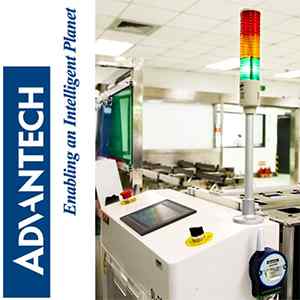Articles
Difference between RTD & Thermocouple
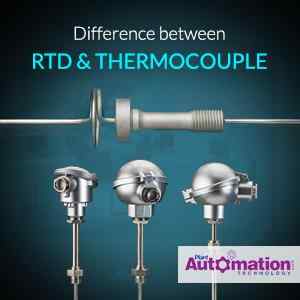
What is RTD?
RTDs stands for ‘Resistance Temperature Detectors’ and they are generally referred to as ‘Resistance Thermometers’. RTD can be defined as a temperature sensor that operates on the measurement principle where the materials’ electrical resistance changes with temperature.
The American Society for Testing and Materials (ASTM) has defined the term resistance thermometer as follows:
Resistance thermometer, n. - a temperature-measuring device composed of a resistance thermometer element, internal connecting wires, a protective shell with or without means for mounting a connection head, or connectingwire or other fittings, or both. [Vol. 14.03, E 344 – 02 § 3.1 (2007).]
A RTD element consists of a wire coil or film made of pure metal. The element’s resistance increases with temperature in a repeatable and known manner. They show excellent accuracy over a wide temperature spectrum. RTDs are also relatively immune to electrical noise and therefore well suited for temperature measurement in industrial environments. Platinum is the most commonly used material in the construction of RTDs as they have a huge number of factors such as a) chemical inertness b) nearly linear temperature versus resistance relationship, c)temperature coefficient of resistance that is large enough to give readily measurable resistance changes with temperature and d) stability.

RTD (Resistance Temperature Detector)
The resistance of RTD can be calculated by supplying an RTD with a constant current and evaluating the resulting voltage drop across the resistor. By calculating the RTD resistance, the temperature can be determined. RTD elements are made using different materials such as nickel, platinum, copper etc.
Importance of RTD:
RTDs are used to measure temperature in laboratories and industrial processes, and they are known for their accuracy, stability, and repeatability characteristics. They can be used in all but the highest temperature industrial processes.
Made using platinum, RTDs are very stable and are not affected by corrosion or oxidation. They boast high repeatability, which means that they can measure identical temperatures accurately even when exposed to repeated heating and cooling cycles with minimal discrepancies.
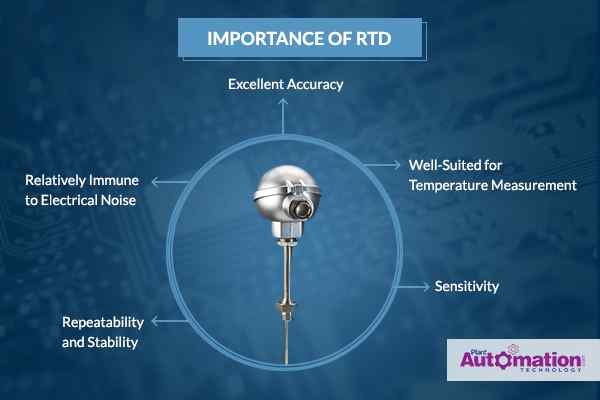
Importance of RTD
RTDs are ideal solution for various applications because of the following factors:
• Excellent Accuracy
• Repeatability and stability
• Sensitivity
• Well-suited for temperature measurement
• Relatively immune to electrical noise
Uses of RTD:
RTDs offer various benefits, which are mentioned below:
• Resistance temperature detectors (RTDs) provide very accurate measurements and hence they prove to be the most accurate temperature sensors.
• Range: -200 C to 850 C
• RTDs are very simple to recalibrate.
• They also give repeatability and excellent stability.
• Sensitivity: Excellent sensitivity over narrow spans
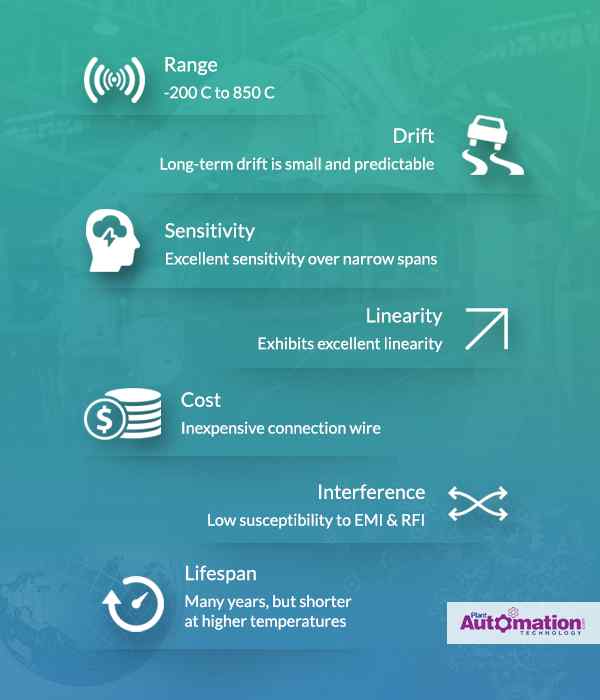
Benefits of RTDs
• Drift: Long-term drift is small and predictable
• RTDs tend to provide stable output for longer periods of time.
• They always exhibit excellent linearity
• Interference: Low susceptibility to EMI & RFI
• Cost: Inexpensive connection wire
• Lifespan: Many years, but shorter at higher temperatures
• RTDs provide immunization against electrical noise. Therefore, they are considered ideal for temperature measurements in industrial environments.
Applications of Resistance Temperature Detectors
RTDs can be used in:
• Air conditioning and refrigeration servicing
• Food Processing
• Stoves and grills
• Textile production
• Plastics processing
• Petrochemical processing
• Micro electronics
• Air, gas and liquid temperature measurement
• Exhaust gas temperature measurement
What is Thermocouple?
A thermocouple is an electrical device which is extensively used for measuring temperature. It consists of two dissimilar electrical conductors forming electrical junctions at different temperatures.

Thermocouple
The American Society for Testing and Materials (ASTM) has defined the term Thermocouple as follows:
Thermocouple, n. - in thermometry, the sensor of a thermoelectric thermometer, consisting of electrically conducting circuit elements of two different thermoelectric characteristics joined at a junction. [Vol. 14.03, E 344 - 02 § 3.1 (2007).]
They consist of two metals joined together to form two junctions.
a) Hot or Measuring Junction: One metal is connected to the body whose temperature is to be measured.
b) Cold or Reference Junction: The other metal is connected to a body of known temperature.
This means that the thermocouple measures unknown temperature of the body with reference to the known temperature of the other body. Thermocouples can measure a wide range of temperatures and they are self powered and require no external form of excitation.
Importance of Thermocouples:
Thermocouples are easy to use, and they are the most durable temperature sensors. They are very user friendly and help to retrieve results quickly. The major advantage that a thermocouple offers to us is the temperature range. It can be used for a very wide range of temperatures.
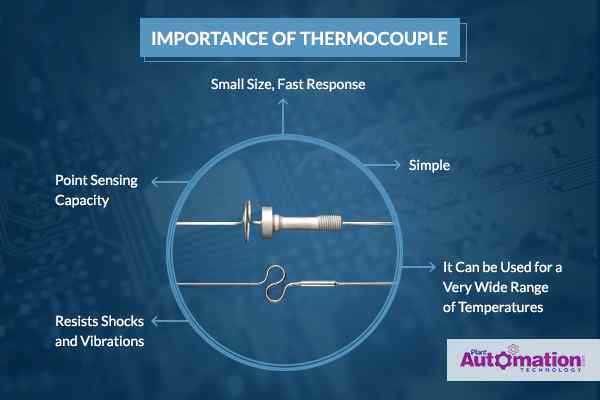
Importance of Thermocouple
Thermocouples can be made using common materials such as nickel, iron; They are also made of rare and expensive materials such as rhodium and platinum.
Thermocouples play an important role in industrial applications because:
• Small Size, Fast Response
• Simple
• It can be used for a very wide range of temperatures
• Resists shocks and vibrations
• Point sensing capacity
Uses of Thermocouple:
Thermocouples play a key role in science and engineering, due to features such as their fast reaction time and small size. They have the capability to accurately measure extreme temperatures, with ranges from ranges from 270 to 2,500 degrees Celsius, and errors within 0.5 to 2 degrees Celsius.
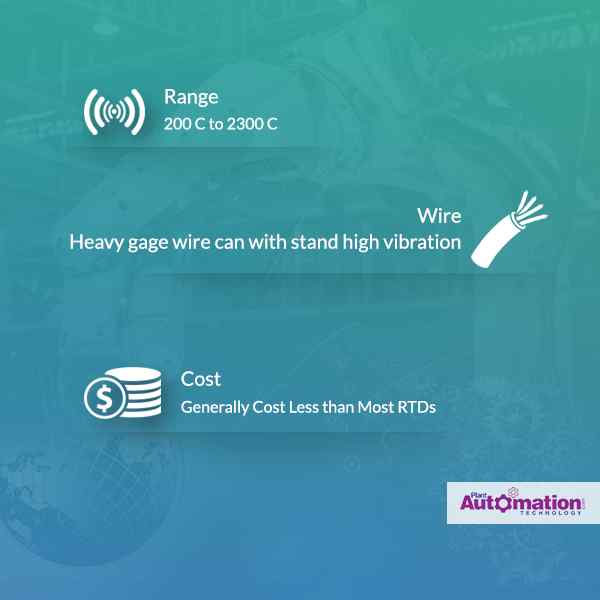
Uses of Thermocouples
They are used as hospital thermometers, and in diagnostics testing for vehicle engines. They can also be used in various gas appliances such as water heaters, boilers, and ovens.
Applications of Thermocouples:
Thermocouples are widely used in science and industry. They can be used for gas turbine exhaust, kilns, diesel engines, and other industrial processes. They can also be used in offices, homes, and businesses as the temperature sensors in thermostats.
4 Factors to Choose the Best Temperature Sensor for your Application
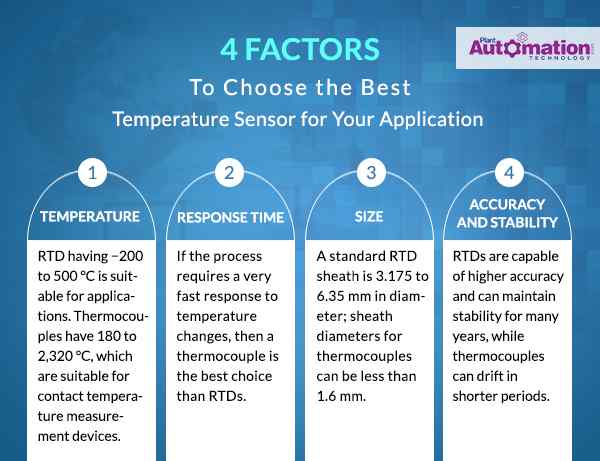
4 Factors to Choose the Best Temperature Sensor for your Application
Temperature: An industrial RTD is preferred when the process temperatures are between −200 to 500 °C. Thermocouples have a range of -180 to 2,320 °C; therefore, temperatures above 500 °C Thermocouples are your only choice of contact temperature measurement devices.
Response Time: If a process requires a fast response to temperature changes, then preferring thermocouple is the best choice.
Size: A standard RTD sheath is 3.175 to 6.35 mm in diameter; sheath diameters for thermocouples can be less than 1.6 mm.
Accuracy and stability requirements: RTDs are capable of higher accuracy and can maintain stability for many years, while thermocouples can drift in shorter periods
RTD Vs Thermocouple:
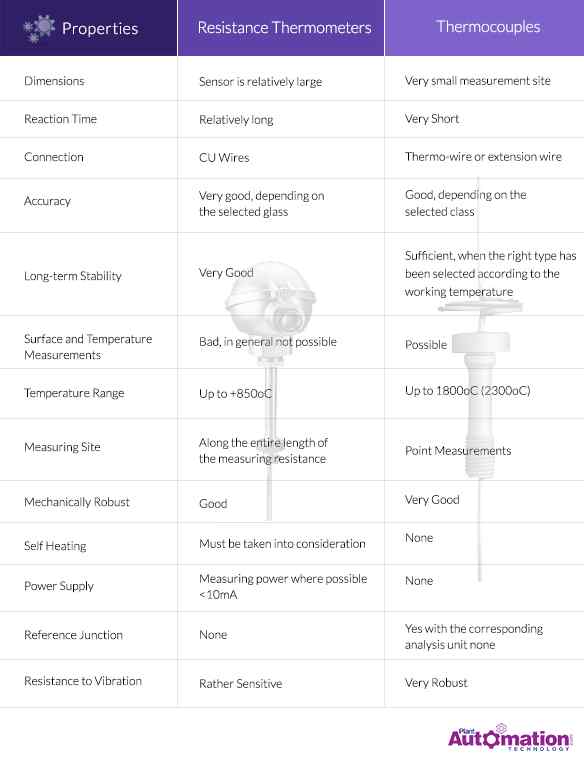
RTD Vs. Thermocouples
Both RTDs and Thermocouples have their own advantages and disadvantages. They can be used for various applications. In fact, RTDs are used in large volumes compared to thermocouples in many industrial applications below 500°C.


